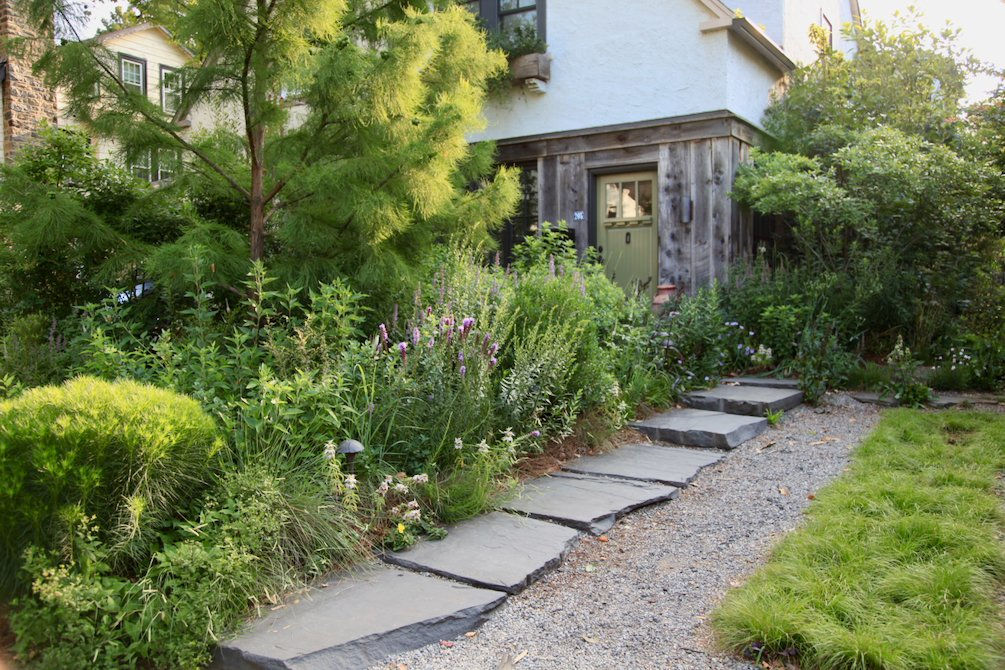
Garden Design to Help Absorb Stormwater and Prevent Flooding
As rain events have become more intense and more frequent... ...you may have noticed stormwater from the street flooding your property, rainwater from downspouts carving gulleys into your yard, or a wet patch that never seems to dry out. Refugia’s style is naturally well-suited to the task: The native plants that they work with are good at Lorenz’s three rules of stormwater management: Photography by Kayla Fell, courtesy of Refugia Design. Refugia’s garden for the Bryn Mawr Film Institute manages runoff from the roof and neighboring parking lot through a mix of diverse flowering perennials and grasses with a variety of root depths. “Rain gardens seem complicated, and sometimes they are for good reason... ...especially in larger applications, but for most residential settings, just creating larger, more vegetated planning beds has a great impact on stormwater issues,” says Lorenz. Reduce your lawn and increase your beds. The site at Bryn Mawr Film Institute before Refugia’s landscape redesign. The first order of business was to reduce the “green concrete” of lawn and replace it with resilient plants with a variety of root structures. Refugia dramatically reduced the amount of lawn in this front yard... Rethink how your care for your lawn. ...replacing it with plants that will help to soak rainwater back into the ground while simultaneously increasing biodiversity in the landscape. Lorenze notes that in trials at the Mt. Cuba Center wood’s sedge (Carex woodii) was the best performing sedge lawn alternative for the Mid-Atlantic that can tolerate moderate traffic. Your irrigation might also need some rejiggering. Lorenz’s own home demonstrates many of the principles of stormwater management, including dense plantings, a sedge lawn instead of turf, and a variety of root structures—not to mention permeable pathways. Seek out native, resilient plants. “Carexes might not produce a root system quite as deep as switchgrass, but they will help slow water down and soak it up,” he says; for example, Pennsylvania sedge (Carex stricta, pensylvanica) and fox sedge (Carex vulpinoidea) produce root systems from 12 to 24-inches deep. For the Bryn Mawr Film Institute garden, Refugia Design replaced turf grass with a filter strip and basin to one side of the pathway that reduces runoff from the adjacent parking lot. This is especially true if you have a lot of water coming off your roof and the downspouts pass through your beds. “One of the key things that we look at is a diversity of root systems,” says Lorenz. Companion plant for better water absorption. Refugia uses switchgrass, like Panicum virgatum ‘Shenandoah’ seen here in the foreground, in its rain gardens because its dense clumps slow water down and its vigorous root system helps water soak back into the ground. Add this stormwater superstar. Its root systems can be three times the size of the aboveground plant, and not only can it help water soak in... ...it can help filter petroleum-based pollutants out of the water if you plant it where it will catch un-off from your driveway or the street. Reclaim your soggy spots. A mix of medium and large stones positioned near a downspout prevent soil erosion and mimic the look of a natural stream. Use the dirt you’ve excavated to create a gentle berm around the perimeter to help direct the water where you want it to go and avoid overflow in the depression. Water finds the path of least resistance, and you can often see evidence of where it naturally wants to flow. If you have a place where a gully has formed, Lorenz suggests creatively putting some stones and plants into the path of where the water flows; this could be a decorative arrangement of small and medium-sized stones right at the end of a downspout or boulder-sized rocks and shrubs in the path of an overflowing street drain. This garden features a bioswale that was exacavated from the lawn to create a depression to hold rainwater and act as a filter strip to the road. If water flows off the street or your driveway, you might consider planting a “filter strip,” which is planted along the sloped areas commonly found alongside roads, or even a mini bioswale, which is intentionally dug out to hold and direct water. As you make changes on your property, share your efforts with your neighbors, especially anyone who is in the same path of stormwater. 
